|

 | |
Steep Tele Turns: The Sequence
Many great tele skiers will tell you that it is
all about the hands. Get your hands in the correct position and the body
and legs will follow. We broke these still pictures out of a video of
Big Tim (the "Steep Turns" movie in the Tele-Vision Archive) to
illustrate the point.
In the first shot Tim is
compressed from the last turn and bringing his new downhill hand and
pole forward, in frame 2 you can see that his uphill hand is beginning
to drive forward and around before he even plants his downhill pole and
his upper body is beginning to open up and face down the fall line, in 3
he has fully extended his legs, or nearly so, and his uphill hand is
driving around hard, his torso is following and his legs are about to
"unwind" beneath him.
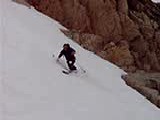 |
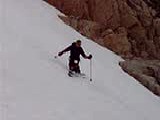
|
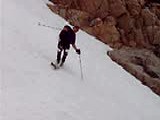 |
Just milliseconds later in frame 4
you can see his skis have indeed unwound, notice how much his skis have
rotated from frames 3 to 4 without moving downhill in relation to his
planted pole. In 5 he lands on the lead ski first and in 6 stomps that
back ski hard. He may be leaning into the hill a little more than he
would like to be, a common problem. See how he lands in the fall line
and finishes the turn on the snow. He does not jump all the way around
and waste energy.
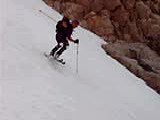 |
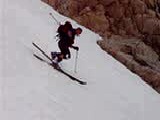
|
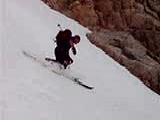 |
In the last three frames you can
see his new downhill hand moving forward to plant his lower pole while
his new uphill hand is moving forward and the sequence begins again. You
can see that he has recovered his stance, leaning more out away from the
hill.
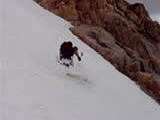 |
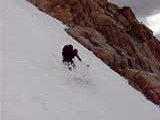
|
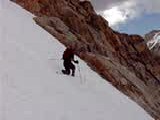 |
Tim skis the steeps efficiently by landing in
the fall line, compressing to harness the energy from the turn then
rebounding upward while driving his hands downhill. You can clearly see
that his hands are leading the way in frames 2 and 3, again, take
special note of the fact that in frame 2 his uphill hand has begun
driving forward and down before his downhill pole is even planted. Many
tele-ers get into trouble by planting THEN driving the uphill hand
around, if you wait that long you will have lost a lot of energy and
your skis will not come around fluidly and quickly.
Quick Hit: Living Through Death Crust
Every once in a while I get a chance to find out
that the things I think, read and write about actually work. This happened
most recently last week when I was at the end of a two-day- old-powder
run. There was a short, sun exposed, 5 turn steep pitch with a nice little
crust over it. I thought about moving over to the shady aspect where the
powder was but decided instead to try the old breakable techniques.
I summoned up all I had heard and all I
remembered about. I discarded the hop turn and hope approach in favor of
something more fluid. I tried this: compressing real low into the first
turn (real low) I exaggerated my upward motion (a lot) and drove my
outside hand toward the fall line and up. The skis actually came up
through the mank to somewhere near the top of the crust layer. I made a
very quick lead change and instead of dropping right onto the rear ski
like I usually do, I punched the front ski down and applied a bunch of
twist to it, then I powered the rear ski. I cut the turn short (coming too
far around is an invitation to disaster in this stuff) and repeated the
sequence.
The key is the real low compression and the
dynamic extension as you stand up. The rest of the moves are important
too, neglect one and the sequence will fail.
I'll be darned if it didn't work! I was able to
link all five turns. I never really got going all that fast and felt in
control the whole time. It was actually kind of fun. I suppose fifty of
those turns might be a different proposition, but it was great to know
that this technique would work in at least some kinds of death crust.
Quick Hit: Hand Position and Frog Gigging
Even advanced telemark skiers can benefit from an
examination of their hand and pole position. If you get lazy and let this
fundamental slide a bit, you will not be able to realize your full
potential on the slopes.
Good skiers, alpine or telemark, keep their hands
under control never flailing. Your hands should be at the edge of your
vision at all times, if you can't see your hands then they are too far
down and back. Get them up and forward. This is usually more of a problem
when making GS style turns, it is easy to get complacent and let those
hands drift back. Short radius turns usually find us working the poles a
lot more, although it is still easy to let the off hand go.
| A ski partner that I often hook
up with at Tioga Pass in the spring ( an experts expert: he is the
Masters Program race coach at Squaw Valley ), once told me to think of
"frog gigging". "Have you ever been frog gigging?" he asked me. "No, I
don't believe I have" I answered. "Well, you gig frogs with a
flashlight and a spear, you point the flashlight at the frog to freeze
him and get him with the spear. As you are getting ready to make your
next pole plant you should have your poles in the frog gigging
position, the downhill pole is the spear and the top of the grip of
the uphill pole is the flashlight, the 'frog' is downhill, reach down
with the spear/pole and shine that flashlight/pole grip at him, then
your hands will be in the correct position!" It was good advice,
whenever I find myself wondering what to do with my hands I think back
to Scott's "frog gigging" analogy and I am back on track. |
 |
Keep you hands moving forward, roll your uphill
hand over to get the top of the grip pointing at the "frog", fight the
natural inclination to let it drop back and you will be on your way to
consistent, powerful hand position.
Another Quick Hit: Skiing Powder
In powder, equal weight distribution is a key
factor, let that back leg go doggie and the rear ski will have a mind of
its own. Exaggerated up/down motion (flexion and extension as it is often
called) is also key. With a strong up/down motion you will not be as
tempted to sit back as you might otherwise be. This tendency to sit back
in powder is very common, it is the inexperienced pwder skier's futile
attempt to "keep the tips up" that leads to "backseatitis". Extending and
retracting the legs aggressively in powder will keep the skis rising to
the surface between turns. This up/down motion is what allows expert
powder skiers to ski the light and dry even on skinny skis. Press your
toes down into the snow at the bottom of the turn to build a platform to
extend off of.
Stay in the fall line, I can't emphasize this too
much. Cut your normal turn down by as much as half, speed is your friend
in powder. Face down the hill and keep your hands out front. These are all
basic skills that need to be re-emphasized in powder.
Be aggressive and concentrate on exaggerating the
basics of the telemark turn and you will find the almost spiritual bliss
that powder skiing is all about.
The Telemark Jump-Turn
"Oh man, how am I going to get down now" I
remember thinking. One third of the way down a 2000 plus vertical foot
descent of Bloody Couloir, I had just managed to arrest a 150 foot slide,
half of which was head first, and I was now shakily standing upright on
the 50 degree slope, rocks on either side and a huge rock prow in the
middle, trying to figure out how this had happened. You see, up to that
very moment I had always believed that my rock solid jump parallel turn,
my "turn of last resort" would see me through anything. This turn had
gotten me out of hairball situations and bad snow for years, why was it
failing me now?
On the climb up, things looked good, about 4
inches of what seemed to be fairly dense fresh on top of a solid base. As
we cramponed up, the wind began to build and the snow was swirling around
some, not that unusual in a narrow Sierra chute at mid-day. We summited,
had lunch and started down. The first twenty turns were challengingly
steep and fun. Then the snow became very inconsistent, the wind had been
blowing it around, there were now areas of sticky powder and patches of
hard ice. I would jump, land and turn through the fall line, gain speed on
the ice and then hit a patch of sticky snow, which would throw me forward
over the tips. A couple of recoveries and then came the big slide for
life. I was in desperate need of a turn I had never bothered to learn: the
telemark jump turn. The answer to dealing with this snow was fore and aft
stability, and in parallel mode I did not have it. I got down that day and
even managed to have a little fun, but I new I had some work to do. Below,
the scene of the spanking.
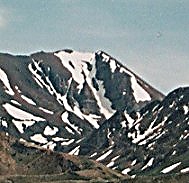
The Basics Of The Telemark Jump Turn
The power to execute the jump-turn comes from
creating a platform on the snow to rebound off of at the end of each
turn. So to start, we begin with a little mini-turn. Traversing a bit
you make this first turn, almost like a garland, push down firmly to
form the platform, sinking and edging hard. Your upper body should be
facing down the fall line, leaning out, reach down the slope and plant
your downhill pole firmly. I make this pole plant just a bit behind my
hip, reaching down and slightly back helps get my upper body in the
right position and, as always, the upper body is a key factor. Now push
up hard off the platform you created at the end of the mini-turn and
begin the jump, up and around the planted downhill pole. When you first
begin the jump, slide your lead ski back and let the new lead ski take
care of itself, don't worry about moving it forward, if you move the old
lead ski back it will be in the right position. Punch that old uphill
hand around and down the slope, this helps speed up the rotation and get
this pole in position for its own downhill plant. Suck up your knees a
bit on landing, absorbing the shock and storing some of that energy for
the next turn. You should have now landed in the tele position and be
ready to begin another sequence.
The Steps
- Traverse
- Platform
- Pole plant
- Jump
- Lead change
- Land
- Traverse
- Platform...
Once you have mastered the steps above then you
can begin to experiment with shortening up the traverse. While you are
traversing you dissipate the energy that you have stored up from the
last turn, this is good for learning, it gives you a moment to recover
and get your bearings, but it is an exhausting way to ski. Instead of
letting that stored energy go to waste, shorten or even eliminate the
traverse and pop from one turn to another. Land the turn, sink, edge,
platform, pole plant, pop up and turn.
The telemark jump turn is much like an alpine
style jump turn with the key point of difference (and the thing that
largely determines the success) being the quick early lead change at the
start of the jump portion. Remember, slide the old lead ski back early.
I like to think of myself sliding it back and landing on it, leaving the
new lead ski to largely take care of itself. Drill the sequence into
your brain and repeat the moves over and over until it becomes easy, and
don't worry, it will.
Practice the jump turn whenever you can, it is
actually easier to perform on steeper slopes where gravity and the slope
angle work to the your advantage. Practice it on the steeper groomers
and on backcountry mixed snow conditions, everywhere you can. The
telemark jump turn is a necessary and valuable tool in the quiver of
turns. It is the only effective free heel jump turn for certain
situations, take it from me, I learned this the hard way!
|
Previous Advanced Lesson
Skiing Stiff Snow and
Making it Fun!
..We
all know that no matter where you live and ski, the snow is often less
then epic. Even on a great morning, we can be just an hour of strong sun
away from the subject of this lesson: heavy snow. Old and/or heavy pow,
cut up stiff crud, bottomless mush, a little technique adjustment and the
fun can keep on coming.
.The
major key to turning this kind of snow into fun is weighting that rear
ski. .Always
important, it is absolutely mandatory in the kind of conditions we are
talking about here. This kind of snow is where all that practice of good
fundamentals comes into play. Here is where a solid upright stance,
allowing you to get more weight then ever on that back ski pays off.
Concentrate on the basics, remaining fluid at all times. Exaggerate your
up/down motion a bit, try to ski it like real powder, but with more
emphasis on the rear ski, staying in the fall line and keeping your turns
short and powerful, keeping the rebound meter pegged.
..One
of my ski partners talks about riding the back ski and using the front ski
almost like a brake, extending his front leg a little more when nearing
the end of the turn and pushing the front ski down into the snow, slowing
himself to remain in control and building rebound energy for the
initiation of the new turn, then immediately getting back onto the rear
ski for the carved arc portion of the new turn. I like his brake analogy
because it really drives home the point, the power in modern telemark
skiing comes from the rear ski, especially in this kind of snow.
..Another
adjustment for this type of snow that you might want to try, is to make
sure you are not using a lot of upper body angulation out away from the
slope. This is good technique for harder snow but could leave you with a
pretty thin margin for error when being buffeted by heavy mank. Don't lean
into the slope either, again think powder.
..Sometimes
I see telemark skiers looking so smooth, too smooth even, and then I see
why, they are really not skiing very dynamically, they have gotten into
the habit of skiing with very little up/down motion. This has got to be
one of the most deadly sins that will come back to haunt you in stiff
snow. When we ski powder we use a very dynamic approach, and so it should
be with mank and other stiff snow, try to muscle this stuff and you will
not win. Flow with it.
..Try
skiing the stiff snow just like powder, adjusting your technique as
outlined above and see if that mean old snow can become your friend and
put a smile on you face.
|
|